Abstract
The damage mechanism of proton irradiation in InP/InGaAs heterostructures was studied. The deep level traps were investigated in detail by deep level transient spectroscopy (DLTS), capacitance–voltage (C–V) measurements and SRIM (the stopping and range of ions in matter, Monte Carlo code) simulation for non-irradiated and 3 MeV proton-irradiated samples at a fluence of 5 × 1012 p/cm2. Compared with non-irradiated samples, a new electron trap at EC-0.37 eV was measured by DLTS in post-irradiated samples and was found to be closer to the center of the forbidden band. The trap concentration in bulk, the interface trap charge density and the electron capture cross-section were 4 × 1015 cm−3, 1.8 × 1012 cm−2, and 9.61 × 10−15 cm2, respectively. The deep level trap, acting as a recombination center, resulted in a large recombination current at a lower forward bias and made the forward current increase in InP/InGaAs heterostructures for post-irradiated samples. When the deep level trap parameters were added into the technology computer-aided design (TCAD) simulation tool, the simulation results matched the current–voltage measurements data well, which verifies the validity of the damage mechanism of proton irradiation.
1. Introduction
The InP/InGaAs material system has the advantages of high electron mobility and large hetero-junction offsets, which promote the realization of InP-based heterojunction bipolar transistors (HBTs) in high-speed analog circuits [1]. In space communication systems, the degradations induced by electron [2], neutron [3] and proton irradiation would cause issues of reliability.
Many works have studied the electrical characteristics of InP/InGaAs devices before and after irradiation. In [4], the authors showed that the degradation of current gain and cut-off frequency were caused by proton irradiation in InP HBTs. The increase in offset voltage was induced by neutron irradiation in InP single heterojunction bipolar transistors (SHBTs) [5]. Such degradations of devices were mainly attributed to the defects in InP/InGaAs heterostructures when the devices work in extremely complex spatial irradiation environments [6]. To predict proton induced degradation of InP/InGaAs heterostructures, the nonionizing energy loss model (NIEL) was proposed [7]. All of these previous results have considerably helped with understanding the process of the irradiation damage. However, the proprieties of deep level traps induced by proton irradiation in InP/InGaAs heterostructures have not been reported to date. Therefore, in order to study defects induced by proton irradiation and discuss the recombination current mechanisms of InP/InGaAs heterostructures, it is necessary to study the properties of the traps in InP/InGaAs heterostructures. Deep level transient spectroscopy (DLTS) can conveniently detect the trap positions in the band gap, capture cross-sections, trap types and concentrations.
In this paper, the deep level traps in InP/InGaAs heterostructures are characterized by DLTS, capacitance–voltage (C–V) measurements and SRIM (the stopping and range of ions in matter, Monte Carlo code) simulation for non-irradiated and post-irradiated samples with 3 MeV protons at a fluence of 5 × 1012 p/cm2. The trap parameters were inputted into TCAD to simulate the current characteristics. The traps are responsible for the increase in recombination current and the ideality factor after irradiation in InP/InGaAs heterostructures.
2. Experiments
The device used in this study has a p+-In0.53Ga0.47As/n-InP heterostructure, which was grown by a V90 GSMBE system (Veeco, New York, NY, USA) in the Shanghai Institute of Microsystem and Information Technology (SMIT). The arsenic and phosphorus beams were from thermal cracking of arsine (AsH3) and phosphine (PH3) at a temperature of 410 °C. Elemental gallium (Ga) and indium (In) were used as the group-III sources. Silicon (Si) and CBr4 (C) were used as n-type and p-type dopants, respectively. Figure 1 shows the schematic diagram of the p+-In0.53Ga0.47As/n-InP heterostructure, which consists of the substrate of n-type InP (S: 1 × 1018 cm−3), a 300 nm n-InP (Si: 2 × 1017 cm−3), and a 80 nm p+-In0.53Ga0.47As layer (C: 3 × 1019 cm−3). Si3N4 was used for passivation. Pt/Ti/Pt/Au and Au/Ge/Ni were deposited by electron beam evaporation and then alloyed for p- and n-type ohmic contacts, respectively.
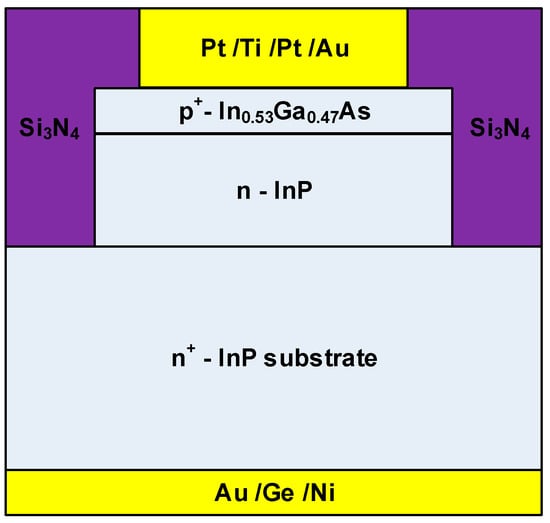
Figure 1.
Schematic diagram of the InP/In0.53Ga0.47As heterostructure.
Prior to irradiation, the characteristics of current–voltage (I–V) and capacitance–voltage (C–V) were measured at room temperature. The DLTS measurements were carried out using a HERA-DLTS system (FT 1030 1 MHz, PhysTech, PhysTech GmbH Am Mühlbachbogen 55d D—85368 Moosburg, Germany) in deep level transient Fourier spectroscopy (DLTFS, PhysTech GmbH Am Mühlbachbogen 55d D—85368 Moosburg, Germany) test mode. Compared with the conventional DLTS test, the transient amplitude could be calculated at any temperature using a Fourier transformation, and the DLTS spectra were obtained by direct DLTFS and temperature scan maximum analysis. The test temperatures were set from 30 K to 300 K.
The samples without bias were irradiated by 3 MeV protons at room temperature with a proton accelerator EN2 × 6 (High Voltage Engineering Europa B.V., Amsterdamseweg 63 3812 RR Amersfoort, Netherlands) in Peking University. The proton fluence, beam density and total irradiation time were 5 × 1012 p/cm2, 0.027 nA/cm2 s, and about 1 h, respectively.
3. Results and Discussion
3.1. C–V and DLTS Measurements
The C–V measurements were performed at 1 MHz to study the effects of proton irradiation on junction capacitance. Figure 2 shows the results of C–V measurements in non-irradiated and post-irradiated samples at 300 K. The differences in junction capacitance between non-irradiated and post-irradiated samples indicate that there are different amounts of interface traps in InP/InGaAs heterostructures, which might be caused by irradiation or the fabrication process of the hetero-interface. A method of calculating the interface trap charge density σi was proposed by Kroemer et al. [8,9,10], which can be expressed by Equation (1).
where ND (x) is the impurity concentration distribution and n(x) is the apparent majority carrier concentration at position x, which is derived from the C–V profile according to the relation
where
where x is the width of the depletion layer, which is essentially the distance of the depletion layer edge from the p–n junction, V is the reverse bias voltage, C is the capacitance per unit area, Ɛr is the relative dielectric constant of the material of the lightly doping side, and Ɛ0 is the vacuum permittivity. Thus, the apparent carrier concentration distribution n(x) could be obtained from Equations (2) and (3). As shown in Figure 3, the apparent carrier concentration decreases after irradiation and the maximum value is reduced to 5 × 1016 cm−3, which suggests that more interface traps are generated in post-irradiated samples. Therefore, from Equation (1), the interface trap charge densities of the non-irradiated and post-irradiated samples are σi = 5 × 1011 cm−2 and σi = 1.8 × 1012 cm−2, respectively.
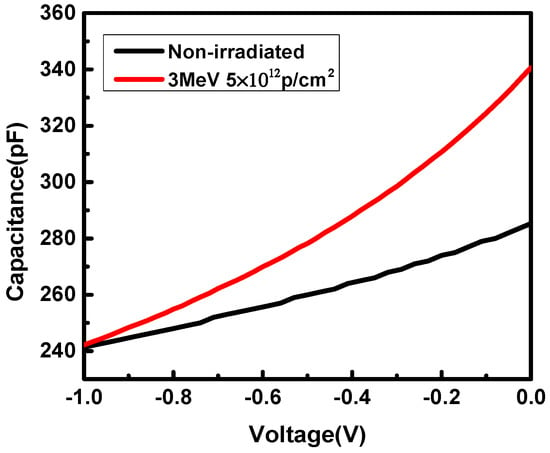
Figure 2.
Capacitance–voltage curves.
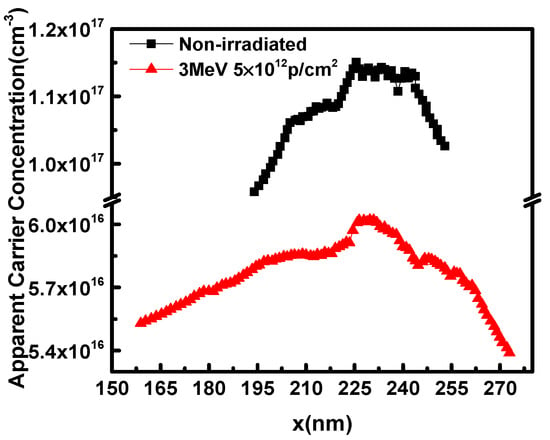
Figure 3.
The apparent carrier concentration profile.
DLTS provides a convenient way to obtain the proprieties of deep level traps, such as trap types, their positions, concentrations, and capture cross-section. Temperature-scan DLTS at a fixed frequency of 1 MHz were used to study the deep level traps in InP/InGaAs heterostructures, with the test condition of reverse bias voltage VR = −2 V, the filling pulse time width tp = 1 ms and a pulse voltage Vp = 0 V to both non-irradiated and post-irradiated samples. At the same time, the DLTS data were acquired digitally for all transient data as a function of scanning temperature cooling from 300 K to 30 K and then heating from 30 K to 300 K in order to reduce the jitter error of the equipment system. Figure 4a shows the typical DLTS spectra measured in InP/InGaAs heterostructures. For non-irradiated samples, a positive peak of the DLTS spectrum appears at the temperature of about 200 K, which indicates the existence of an electron trap [11]. There is a hump near 150 K, but no trap is detected, which is due to the low density of electrically active defects [12]. While for post-irradiated samples, a new electron trap is detected at the temperature of about 235 K.
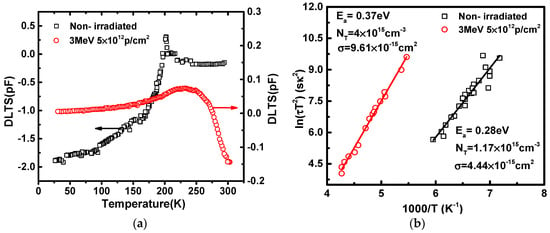
Figure 4.
The measurement results before and after 3 MeV proton irradiation in InP/InGaAs heterostructures. (a) DLTS spectra and (b) The Arrhenius plot for deep level traps.
Then, the relationship between the emission rate en and the temperature is given in Equation (4) [11].
where en is the electron emission coefficient, τe is the emission time constant, σn is the capture cross-section of the electron, vth is the thermal velocity, NC is the state density in the conduction band, EC is the bottom of the condition band, ET is the trap level, k is the Boltzmann constant and T is the temperature. If Equation (4) is re-arranged, one obtains the Arrhenius presentation in Equation (5)
where γ is a collection of constants that depend on the effective mass of the carrier and properties of the band gap. The activation energy (Ea = EC − ET) and electron capture cross-section (σn) could be determined from the slope and intercept, respectively.
The trap concentration parameter NT could be obtained by the height of the peaks on the DLTS spectrum,
where ΔC0 is the total amplitude of the transient, C(∞) is the steady-state capacitance, and Nd is the doping concentration.
The Arrhenius plots could be obtained from Equations (4)–(6). Figure 4b presents the Arrhenius plots for the detected traps in InP/InGaAs heterostructures, which were obtained by using different Fourier coefficients of the numerically filtered transient signal [13]. The activation energy (Ea), trap concentration (NT) and electron capture cross-section (σn) could be calculated from these coefficients. As could be clearly seen from Arrhenius plots, the electron trap positions are at EC-0.28 eV and EC-0.37 eV respectively for non-irradiated and post-irradiated samples, the concentrations of these two traps are 1.17 × 1015 cm−3 and 4 × 1015 cm−3, and the electron capture cross-sections are σn = 4.44 × 10−15 cm2 and σn = 9.61 × 10−15 cm2, respectively.
The same electron trap (EC-0.28 eV) was detected in the bulk n-InP in [14]. The damage might be caused by ion implantation in the InP material during the fabrication process, and in this case, the sharp DTLS spectra might be caused by isolated point defects. However, for 3 MeV proton energy with 5 × 1012 p/cm2 fluence, the electron traps (EC-0.28 eV) disappear. This is because the traps at EC-0.28 eV are filled with carriers induced by the proton ionization effect, which means) of the new trap is closer to the center of the energy band gap, which would have a more serious influence on the characteristics of InP/InGaAs heterostructures.
3.2. The Simulation of Proton Irradiation Damage by SRIM
The proton irradiation damage in InP/InGaAs heterostructures was simulated by SRIM. After proton irradiation, the In and P atoms displaced from their lattice sites, resulting in defect centers. Figure 5 shows the vacancy concentrations in the n-InP layer with 3 MeV proton irradiation at the fluence of 5 × 1012 p/cm2. The oscillation is caused by the calculation of random processes in SRIM; however, the trend generally increases with increasing incident depth. The densities of In vacancies are obviously higher than P vacancies and the average concentration of the In vacancy is about 4.18 × 1015 cm−3, which is close to the DLTS measurements. The In vacancy causes acceptor-like defects in the InGaAs/InP layer heterostructure according to [15], which also corresponds to the electron traps measured by DLTS. Both the DLTS measurement and the SRIM simulation results represent the trap concentrations in the bulk region, while the C–V analysis shows the trap densities at the interface. The results are summarized in Table 1. The influence of traps on current characteristics is discussed below.
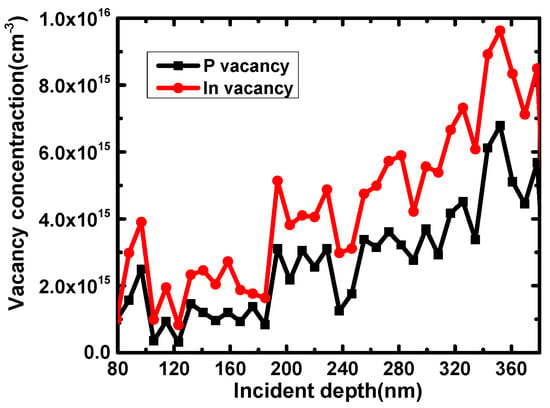
Figure 5.
In vacancies and P vacancies in InP/InGaAs heterostructures with 3 MeV proton irradiation at the fluence of 5 × 1012 p/cm2.

Table 1.
The traps in InP/InGaAs heterostructures obtained by DLTS measurement, C–V analysis, and SRIM simulation.
3.3. The Effect of Deep Level Traps on Current Characteristics
The empirical form of the current–voltage relationship of the pn junction is shown in Equation (7) [16]. By taking logarithms of both sides of Equation (7), the linear curves of ln(JF)~V are given in Equation (8),
where JF is forward current, J0 is reverse saturation current, q is the electronic charge, V is the applied voltage, k is the Boltzmann constant, T is the temperature, and η, the ideality factor, equals 2 when the recombination current in the space charge region dominates [7], and η equals 1 when the diffusion current primarily contributes towards JF. When both currents are comparable, η has a value between 1 and 2.
Figure 6 shows the semilog plot of the I–V measurements without and after 3 MeV proton irradiation at the fluence of 5 × 1012 p/cm2 at 300 K. It is noted that forward current increases significantly after irradiation. Especially in the lower bias, the change of current is more obvious. Similar behavior was reported in [4], which investigated the base-emitter (BE) junction of InP/InGaAs HBTs under the same irradiation condition. The ideality factors (η) could be extracted from the slope of ln(JF)~V curves in Figure 6, which was 1.4 for non-irradiated samples and became 2 after 3 MeV proton irradiation at 5 × 1012 p/cm2 fluence. This indicates that the deep level trap, acting as a recombination center, results in a large recombination current at lower forward bias and makes forward current increase in InP/InGaAs heterostructures. For non-irradiated samples, the traps stemmed from the process technology of the hetero-interface. For irradiated samples, the traps were mainly induced by displacement damage caused by the collision between protons and material atoms. The parameters of deep level traps were obtained by C–V and DLTS measurements (Section 3.1).
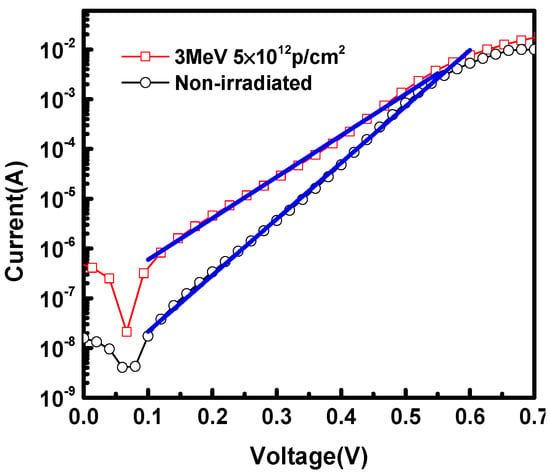
Figure 6.
The semilog plot of I–V measurements without and with 3 MeV proton irradiation at the fluence of 5 × 1012 p/cm2 at 300 K.
Furthermore, the current characteristics of InP/InGaAs heterostructures were simulated by putting the deep level trap parameters into the TCAD tool. Figure 7 shows the simulation and experimental results of I–V plots at 300 K before and after irradiation. The simulation results matched the experimental results well, which indicates that for post-irradiated samples, the deep level traps with an energy level at EC-0.37 eV induced by proton irradiation are responsible for the increasing recombination current at lower forward bias in InP/InGaAs heterostructures. Therefore, deep level traps acting as recombination centers have a great influence on the transport of carriers.
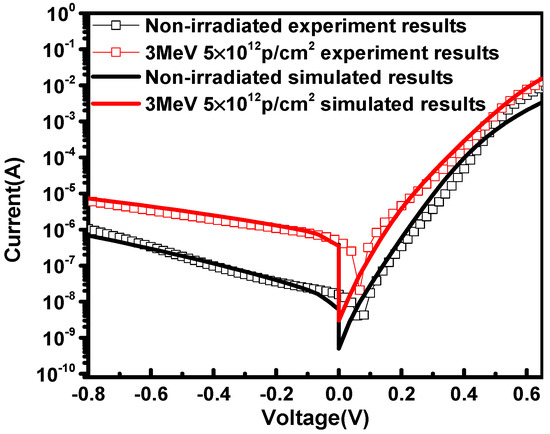
Figure 7.
The experimental and simulated I–V curves before irradiation and after 3 MeV proton irradiation in InP/InGaAs heterostructures.
4. Conclusions
The damage mechanism of proton irradiation in InP/InGaAs heterostructures was studied. The deep level traps were analyzed in detail by DLTS, C–V measurements and SRIM simulation for non-irradiated and 3 MeV proton irradiation at the fluence of 5 × 1012 p/cm2. For non-irradiated and post-irradiated samples, the trap energy positions were at EC-0.28 eV and EC-0.37 eV respectively, the trap concentrations (NT) in bulk of these two traps were 1.17 × 1015 cm−3 and 4 × 1015 cm−3, the electron capture cross-sections (σ) were σn = 4.44 × 10−15 cm2 and σn = 9.61 × 10−15 cm2, and the interface trap charge densities were σi = 5 × 1011 cm−2 and σi = 1.8 × 1012 cm−2, respectively. Compared with non-irradiated samples, a new electron trap was measured by DLTS for the post-irradiated samples and was closer to the center of the forbidden band. The SRIM simulation results revealed that the trap types are mainly associated with Indium vacancies, as the concentration of them coincided with the DLTS measurements in the n-InP bulk. The deep level trap acting as a recombination center results in a large recombination current at a lower forward bias and makes forward current increase in InP/InGaAs heterostructures. After adding the deep level trap parameters into TCAD simulation tools, the simulation results matched the current–voltage measurements results well, which verifies the validity of the damage mechanism of proton irradiation.
Author Contributions
Conceptualization, X.Z.; Methodology, X.Z.; Software, M.Z.; Validation, X.Z. and M.Z.; Formal analysis, X.Z.; Investigation, M.Z.; Resources, H.L.; Data curation, M.Z.; Visualization, X.Z.; Supervision, H.L., Y.Z. (Yuming Zhang) and Y.Z. (Yimen Zhang); Project administration, H.L.; Funding acquisition, H.L. and Y.Z. (Yuming Zhang); Writing—original draft, X.Z.; Writing—review & editing, Y.Z. (Yimen Zhang).
Funding
This research was funded by Advance Research Foundation of China (Grant No. 914XXXXX501), National Defense Advance Research project (Grant No. 315XXXXX301) and Frontier innovation program (Grant No. 48XX4).
Acknowledgments
The authors would like to acknowledge the support of InP/InGaAs heterostructure samples provided by Institute of Microelectronics and Institute of Microsystem and Information Technology (SMIT). The proton irradiation was implemented in the Peking University Irradiation Center. The DLTS measurements were made in Zhejiang University.
Conflicts of Interest
The authors declare no conflict of interest.
References
- Urteaga, M.; Griffith, Z.; Seo, M.; Hacker, J.; Rodwell, M.J. InP HBT technologies for THz integrated circuits. Proc. IEEE 2017, 105, 1051–1067. [Google Scholar] [CrossRef]
- Shatalov, A.; Subramanian, S.; Chandrasekhar, S.; Dentai, A.; Goodnick, S.M. Electron irradiation effects in polyimide passivated InP/InGaAs single heterojunction bipolar transistors. IEEE Trans. Nucl. Sci. 1999, 46, 1708–1715. [Google Scholar] [CrossRef]
- Shatalov, A.; Subramanian, S.; Dentai, A. Neutron irradiation effects in InP/InGaAs single heterojunction bipolar transistors. IEEE Trans. Nucl. Sci. 2000, 47, 2551–2556. [Google Scholar] [CrossRef]
- Liu, M.; Zhang, Y.; Lu, H.; Zhang, Y.; Zhang, J.; Ren, X. Investigation of proton irradiation effects on InP/InGaAs double heterojunction bipolar transistors. Solid-State Electron. 2015, 109, 52–57. [Google Scholar] [CrossRef]
- Shatalov, A.; Subramanian, S.; Dentai, A.; Chadrasekhar, S.; Goodnick, S.M. Neutron irradiation induced degradation of the collector–emitter offset voltage in InP/InGaAs single heterojunction bipolar transistors. J. Appl. Phys. 2000, 88, 3765–3767. [Google Scholar] [CrossRef]
- Shatalov, A. Radiation Effects in III-V Semiconductors and Heterojunction Bipolar Transistors. Ph.D. Thesis, Oregon State University, Corvallis, OR, USA, 2001. [Google Scholar]
- Li, C.H.; Lu, H.L.; Zhang, Y.M.; Liu, M.; Zhao, X.H. Proton-Induced Degradation of InP/InGaAs HBTs Predicted by Nonionizing Energy Loss Model. IEEE Trans. Nucl. Sci. 2015, 62, 1336–1340. [Google Scholar] [CrossRef]
- Kroemer, H. Determination of heterojunction band offsets by capacitance-voltage profiling through nonabrupt isotype heterojunctions. Appl. Phys. Lett. 1985, 46, 504–505. [Google Scholar] [CrossRef]
- Rao, M.A.; Caine, E.J.; Kroemer, H. Determination of valence and conduction–band discontinuities at the (Ga, In) P/GaAs heterojunction by C–V profiling. J. Appl. Phys. 1987, 61, 643–649. [Google Scholar] [CrossRef]
- Lehovec, K. C–V analysis of a partially depleted semiconducting channel. Appl. Phys. Lett. 1975, 26, 82–84. [Google Scholar] [CrossRef]
- Nelson, I.V.; Thomas, G. Native and Radiation-Induced Defects in III-V Solar Cells and Photodiodes. Ph.D. Thesis, Rochester University, New York, NY, USA, 2019. [Google Scholar]
- Chen, X.Y.; Zhang, Y.G.; Gu, Y. Analysis of dark currents and deep level traps in InP-and GaAs-based In0.83Ga0.17As photodetectors. J. Cryst. Growth 2017, 477, 82–85. [Google Scholar] [CrossRef]
- Weiss, S.; Kassing, R. Deep Level Transient Fourier Spectroscopy (DLTFS)—A technique for the analysis of deep level properties. Solid-State Electron. 1988, 31, 1733–1742. [Google Scholar] [CrossRef]
- McAfee, S.R.; Capasso, F.; Lang, D.V.; Hutchinson, A.; Bonner, W.A. A study of deep level in bulk n-InP by transient spectroscopy. J. Appl. Phys. 1981, 52, 6158–6164. [Google Scholar] [CrossRef]
- Wang, C.; Simoen, E.; AliReza, A.; Sioncke, S.; Collaert, N.; Claeys, C.; Li, W. Deep level investigation of INGAAS on INP layer. In Proceedings of the China Semiconductor Technology International Conference (CSTIC), Shanghai, China, 12–13 March 2017; IEEE. pp. 1–4. [Google Scholar]
- Sze, S.M.; Ng, K.K. Physics of Semiconductor Devices; John Wiley & Sons: Hoboken, NJ, USA, 2006. [Google Scholar]
© 2019 by the authors. Licensee MDPI, Basel, Switzerland. This article is an open access article distributed under the terms and conditions of the Creative Commons Attribution (CC BY) license (http://creativecommons.org/licenses/by/4.0/).